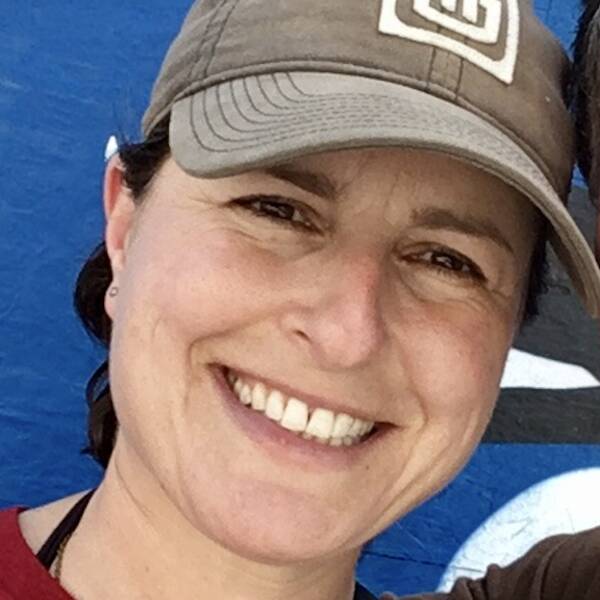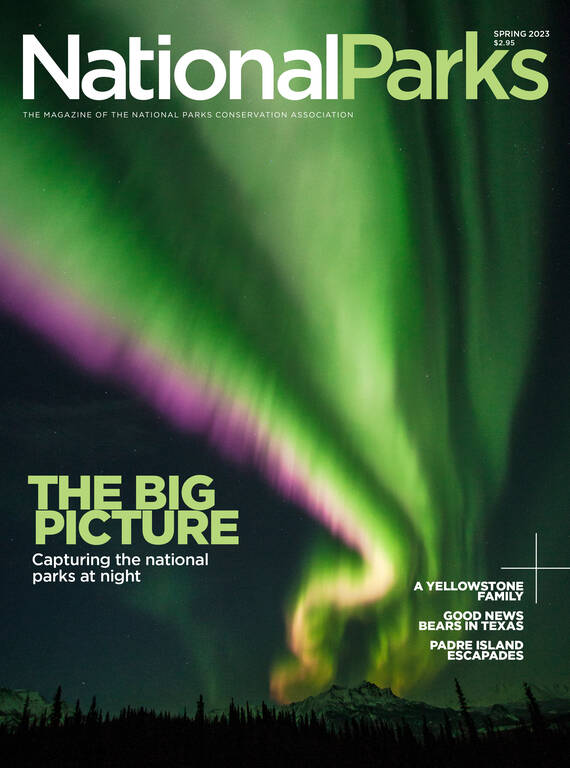Spring 2023
Coprolite Happens
Waste matters in Fossil Butte’s newest exhibition space.
Over several decades at Fossil Butte National Monument, park manager and museum curator Arvid Aase has noticed a clear pattern among arriving visitors, most of whom have driven for hours to reach southwestern Wyoming: The vast majority make a beeline to the bathrooms as soon as they set foot in the visitor center. So when the park started running out of exhibit space and staff wondered where to display more fossils, Aase had an idea. “Wait,” he thought. “We have space in the bathrooms!” And what do you exhibit in the bathroom of a park famous for its fossils? Fossilized feces, of course.
LET’S TALK ABOUT TIME
“I had this idea more than 10 years ago,” said Aase, who has been at Fossil Butte since the ’90s and spent summers before that working in the surrounding fossil quarries to pay for college. The park and commercial quarries are located in one of the world’s richest paleontological regions, an area covered by a lake 52 million years ago. At the quarries, on state and private land, fossil-hunters dig up and sell the preserved remains of fish, crocodiles, mammals and plants from that time. (Wyoming is one of the few states that issues permits for commercial extraction on state land, Aase explained, but there are restrictions to ensure scientifically significant fossils are not sold.) As it happens, prehistoric lakebeds are a good bet for finding fossilized animal waste, which isn’t as plentiful in most other environments. So in the summer of 2021, Aase dropped off 5-gallon buckets at the quarries and asked diggers to toss in coprolites — the fossilized poop that is abundant at these sites. When the buckets filled, he swapped them for empty ones; his goal was to collect 10,000 fossils. The quarriers were happy to oblige; after all, the ancient excrement would otherwise end up in a scrap heap. “Nobody wants to pay money for a small piece of poop,” Aase said.
That fall, the park hired museum technician Dawn Allen-Carlson, a seasonal employee who works at national parks across the country, to sort through and process the buckets of coprolites from the early Eocene Epoch. In her job interview, she learned about the planned bathroom exhibits and thought it was hilarious. “Where else can you show a lot of poop and have it not be offensive?” she said. “I mean, this is where it happens.” She spent three months in a garage sorting thousands of coprolites. At that point, each one looked like a tan piece of rock with an unremarkable bump on its surface formed by the coprolite inside. She drew a square around every bump to indicate where the rock needed to be trimmed to create uniform sizes for display.

6 National Parks That Will Benefit from New Fossil Protections
In early September, the Interior Department implemented a long-awaited rule that will protect fossils from theft and loss on hundreds of public lands, including national park sites. Here are just…
See more ›Allen-Carlson then moved to the park’s fossil prep lab and worked for six months to unearth the fossils from the rock layers. Working with a microscope, she used a pencil-sized instrument that hammers up and down quickly, like a sewing machine needle, to chip away at the rock, and a mini-sand blaster to carefully remove stone closer to the coprolite. Some of the fossils were surrounded by soft limestone that could be blasted off quickly, while others were buried in rock that was much harder to whittle away without damaging the fossil. So some pieces took five minutes to prep; others took all morning. Rangers fielded questions from curious visitors, who could watch Allen-Carlson at work through a sliding glass window. When the first specimen was complete, Allen-Carlson posted pictures on Facebook. She eventually processed thousands of coprolites and organized them into pairs so Aase could create matching exhibits in the men’s and women’s bathrooms.
While the exhibit team couldn’t always tell what animal produced the poop, they knew most were from fish, and the coolest ones taught them something about what the animals ate, said Allen-Carlson, who found bones and scales in some of the coprolites. She also found the coprolites in different environments. “It wasn’t always just a poop on the ground. Sometimes fish would die on top of poop, and they’d be preserved together.” One of the prized finds, which a quarrier first spotted, was a colonite (a poop fossilized in the intestines) still inside the skeletal remains of a fish, visible through its ribs.
Among the surprises: Poop often retains its hue and contours. “I guess that’s part of the beauty of fossils,” Allen-Carlson said. “They get covered fast enough that their degradation is stopped. All the elements that work to destroy it — sun, predators, oxygen for bacteria to eat away at it — are gone.” It was not a surprise, however, that coprolites come in many shapes: round, oval, skinny, fat, spiraling, squiggled, bumpy and conical. Most are 2 inches or shorter, but some are as long as 8 inches, which probably came from turtles or crocodiles.

National Parks
You can read this and other stories about history, nature, culture, art, conservation, travel, science and more in National Parks magazine. Your tax-deductible membership donation of $25 or more entitles…
See more ›Aase grouped the samples according to their shapes and wrote pithy bits of text to accompany the exhibit. Brevity was key, since the bathrooms are small, he said: “We don’t want to back people up in there.” As the exhibit took shape, Allen-Carlson’s work came to a close. To thank her when she departed in late 2022, Aase and his wife stayed on theme: They baked her a cake topped with a chocolate-covered banana and squiggles of chocolate frosting.
The permanent will open this spring with a floor-to-ceiling display case in each bathroom, holding a total of some 1,500 fecal fossils — more fossils than the park has in all other exhibits combined. Visitors will be able to purchase coprolite-themed merchandise, naturally, including limited edition T-shirts. Staff haven’t yet decided which family-friendly slogans they’ll feature, but contenders include “Fossil Butte finally got their coprolite together” and “Come to Fossil Butte for a whole lot of coprolites and giggles.”
“We’re not having any fun with this,” Aase said. “It brings out the 10-year-old in all of us.”
About the author
-
 Melanie D.G. Kaplan Author
Melanie D.G. Kaplan AuthorMelanie D.G. Kaplan is a Washington, D.C.-based writer. Her book, "LAB DOG: A Beagle and His Human Investigate the Surprising World of Animal Research," will be published by Hachette in 2025.



